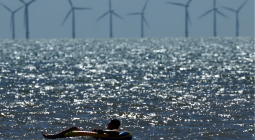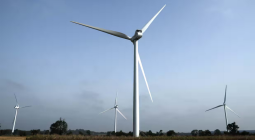Australia could save thousands of bats a year with simple tweak to wind turbines, study says

Experts say increasing the wind speed at which turbines begin to spin could help reduce bat deaths. Photograph: Krystle Wright/The Guardian
Australian windfarm operators are being urged to embrace a simple measure used overseas that scientists say could dramatically reduce the number of bats killed by turbines.
Curtailment – lifting the wind speed at which turbines start spinning – is used in some European countries and parts of the US and Canada, but rarely in Australia. A global study published in the journal BioScience found it was an effective way to limit bat deaths.
Most wind turbines “cut in” at wind speeds of about 3 metres per second and reach maximum output at between 10 and 15m/s. The researchers found increasing the speed at which turbines start turning to 4.5m/s reduced bat deaths on average by 40%. Greater reductions were possible at a higher cut in speeds.
Emma Bennett, an ecologist, has undertaken bird and bat surveys at operating windfarms since 2005. She has estimated bat mortality in Victoria – where there is extensive data – at between 25,000 and 50,000 bats per year.
She said she had been overwhelmed by “the sheer numbers of dead bats I was collecting and identifying” and was driven to find a solution.
Bennett led a four-month trial at a Victorian windfarm that lifted the cut in speed to 4.5 m/s, with the results showing a 54% reduction in bat deaths, but only a 0.16% reduction in energy output and just a 0.09% cut in revenue for the windfarm operator
The trial’s results were published in 2022. She said she had been disheartened by the slow response from industry given the strength of the evidence, but remained “optimistically stubborn” that things could change.
“I am persevering. I feel like there’s no other situation in Australia where we would be killing so many mammals accidentally, where we wouldn’t change our behaviour.”
Curtailment has been listed as a possible mitigating step in draft onshore windfarms guidelines that are due to be finalised by the federal government soon. It has also been included in draft guidelines in NSW. In Victoria, new research aimed at reducing bird and bat collisions with turbines will be completed in October.
Prof Justin Welbergen, an ecologist at the Hawkesbury Institute for the Environment and co-author of the BioScience paper, said curtailment worked because periods of high bat activity often coincided with times of low wind speed, although the specifics varied depending on location and species.
He said the problem was poorly understood in Australia. Despite widespread surveys, the data was not centralised or accessible, making it difficult to investigate and test solutions for the Australian context.
Welbergen said those solutions were important because “we all want more green energy that will benefit our climate and, by extension, biodiversity … including our bats”.
The Australasian Bat Society said it supported renewable energy, but the number of bats killed by windfarms was “already unacceptably high and is expected to increase further as more windfarms are being developed”.
The society has outlined 10 principles to enable a “viable wind industry with no net loss to bat populations”. They included preventing turbines from freewheeling when energy was not being produced and using curtailment to “reduce collision risks”. The society also recommended avoiding development in inappropriate locations, improving scientific rigour for pre- and post-construction studies and better transparency and data sharing.
Bronya Lipski, a senior policy officer at industry group the Clean Energy Council, said the risk to bats could be managed, but “the problems and solutions are complex and blunt approaches like curtailment, aren’t necessarily appropriate”. She said more research was needed.
Prof Brendan Wintle, a University of Melbourne ecologist and lead councillor with the Biodiversity Council, said the evidence showed Australia could have a cost-efficient renewable energy system that was good for nature, including bats.
“It’s just a matter of getting the planning right and getting the regulatory environment right to ensure that happens.”





